What is Sales Velocity: A Comprehensive Guide with Examples
Explore the concept of sales velocity, its key components and metrics. Learn how to measure it to enhance your sales performance and drive business growth effectively.

Explore the concept of sales velocity, its key components and metrics. Learn how to measure it to enhance your sales performance and drive business growth effectively.

Struggling to close deals and hit your sales targets? You’re not alone – approximately 55% of salespeople fail to meet their sales objectives. Many businesses grapple with slow sales cycles and stagnant revenue, which is why optimizing sales velocity is essential. The key metric measures how quickly you generate revenue, factoring in opportunities, average deal value, win rate and sales cycle length.
Businesses can accelerate their sales process by calculating and enhancing their sales velocity. Let us explore the topic in detail, break down the formula and share actionable strategies to enhance the crucial metric.
Sales velocity refers to the metric that measures how quickly a company generates revenue through its sales process. It tracks the speed at which leads progress through the pipeline and converts into closed deals. The metric combines four key elements: the number of opportunities, average deal value, win rate and sales cycle length.
Key objectives:
Tracking sales velocity is crucial for businesses aiming to optimize their sales performance and drive growth.
1. Identify areas for improvement: You can identify targeted areas for improvement by dissecting sales velocity into its key components- opportunities, average deal value, win rate and sales cycle length. The focus lets you enhance lead generation, boost deal sizes, improve conversion rates or shorten the sales cycle effectively.
2. Forecast revenue more accurately: Sales velocity offers a dynamic perspective on your pipeline, leading to more accurate revenue forecasts. The precision enhances financial planning and helps set achievable targets for your sales team.
3. Optimize resource allocation: Grasping your sales velocity enables smarter resource allocation. You can focus your investments where they’ll make the biggest difference by pinpointing the products, markets or customer segments that deliver the highest velocity.
4. Measure and improve sales team performance: Sales velocity is a powerful metric for assessing your sales team’s effectiveness. It transcends basic metrics like call counts or meetings, offering a comprehensive view of how efficiently your team converts opportunities into revenue.
5. Accelerate decision-making: Swift and informed decision-making is essential. Monitoring sales velocity delivers real-time insights into your performance, enabling you to quickly adjust strategies and tactics as needed.
6. Enhance customer experience: Focusing on sales velocity can enhance the entire sales process, positively influencing the customer experience. You create a smoother buying journey by streamlining your sales cycle and boosting communication, leading to increased customer satisfaction.
Let us break down the components of sales velocity and provide a step-by-step approach to calculating it.
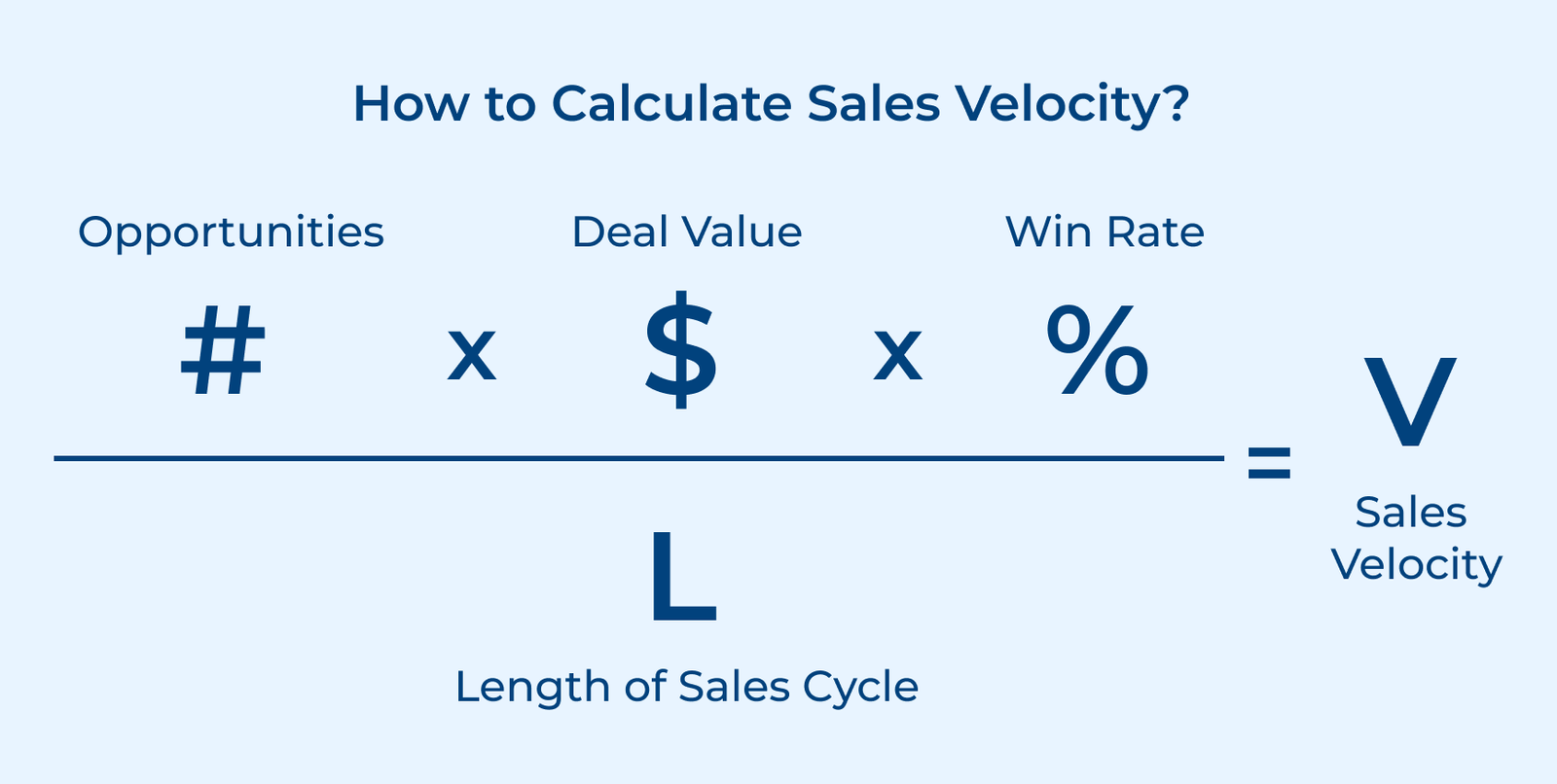
The formula for calculating sales velocity is:
Sales Velocity = (Number of Opportunities × Average Deal Value × Win Rate) ÷ Average Sales Cycle Length
Let’s break down each component of this formula:
1. Number of Opportunities
The metric represents the total count of qualified leads or prospects in your sales pipeline over a defined period.
Formula: Number of Opportunities = Total Leads Generated – Disqualified Leads
The number of opportunities is essential for calculating sales velocity, representing the potential customers your sales team is working to convert. The metric reflects your lead generation efforts, marketing campaigns and lead qualification effectiveness. A greater number of quality opportunities typically signals a healthier sales pipeline and higher revenue potential.
2. Average Deal Value
The average monetary value of closed deals within a specific time frame.
Formula: Average Deal Value = Total Revenue from Closed Deals ÷ Number of Closed Deals
Average deal value reveals the typical size of your sales and is crucial for understanding your revenue potential. It’s influenced by your pricing strategy, product types and upselling effectiveness. Boosting the metric can significantly enhance your sales velocity without needing more leads or a higher win rate.
3. Win Rate
Win rate is the percentage of opportunities that successfully convert into closed deals.
Formula: (Number of Closed Won Deals ÷ Total Number of Opportunities) × 100
Your win rate indicates how effectively your sales team turns opportunities into actual sales, serving as a vital measure of sales efficiency and process quality. Key factors influencing win rate include the strength of your value proposition, sales team effectiveness, lead quality and product-market fit. Enhancing your win rate can significantly boost your sales velocity.
4. Average Sales Cycle Length
It is the average time it takes to convert a lead into a customer, from initial contact to closing the deal.
Formula: Total Time for All Closed Deals ÷ Number of Closed Deals
The average sales cycle length measures how swiftly prospects move through your sales pipeline. A shorter cycle indicates a more efficient process, boosting sales velocity. Factors that influence the include product complexity, sales efficiency, customer decision-making and sales-marketing alignment.
Example of how to calculate Sales Velocity:
Imagine a software company with the following monthly sales data:
– Number of Opportunities: 100
– Average Deal Value: $10,000
– Win Rate: 25% (or 0.25)
– Average Sales Cycle Length: 30 days
Let’s calculate the sales velocity:
Sales Velocity = (Number of Opportunities × Average Deal Value × Win Rate) ÷ Average Sales Cycle Length
Sales Velocity = (100 × $10,000 × 0.25) ÷ 30
Sales Velocity = $250,000 ÷ 30
Sales Velocity = $8,333.33 per day
It means that the company is generating approximately $8,333.33 in revenue per day based on its current sales performance.
Let’s break it down to better understand the result:
So, in a typical month, they would close 25 deals (100 × 0.25) worth $10,000 each, generating $250,000 in revenue. When we divide this by the 30-day sales cycle, we get the daily sales velocity of $8,333.33.
The sales velocity metric provides valuable insights:
1. Shows how quickly the company is generating revenue.
2. Provides a benchmark for future performance.
3. Helps identify areas for improvement. Let’s assume:
– If they increase their number of opportunities to 120, their sales rate will increase to $10,000 per day.
– If they improve their win rate to 30%, their sales velocity will rise to $10,000 per day.
– If they reduce their sales cycle to 25 days, their sales rate would increase to $10,000 per day.
While pipeline velocity and sales velocity are related concepts in sales management, they have distinct differences that are important to understand for effective sales performance analysis.
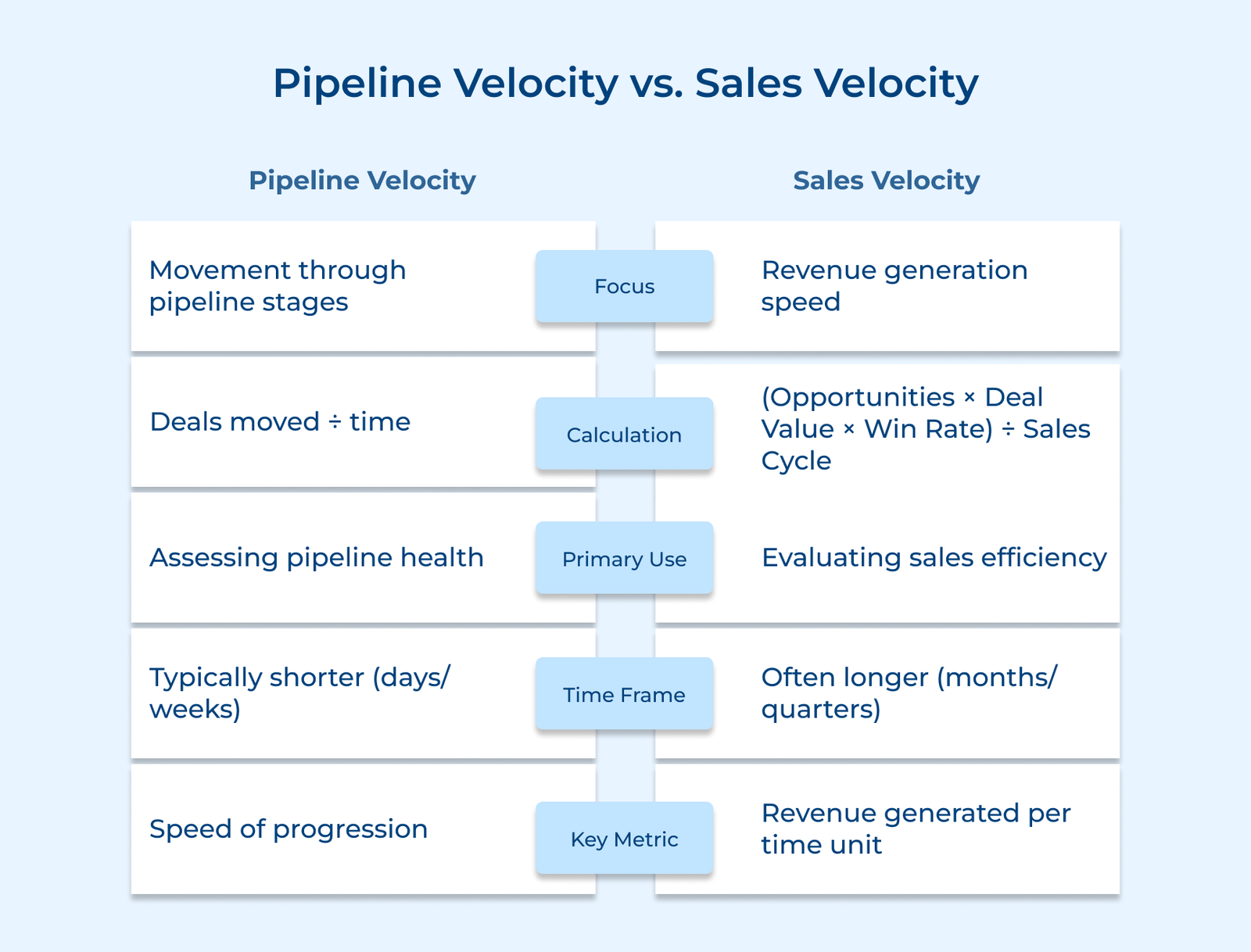
Pipeline velocity: Tracks the flow of opportunities through the entire sales pipeline, from initial contact to closure, whether won or lost. It measures how swiftly leads advance through each stage of the sales process.
Sales velocity: Sales velocity measures how quickly deals are closed and revenue is generated, focusing on successful outcomes rather than the entire journey of all opportunities.
Pipeline velocity: Calculated by combining the number of opportunities, average deal size, win rate and the average time spent in each sales stage, often providing a detailed view of time allocation throughout the pipeline.
Sales velocity: Determined by the number of opportunities, average deal value, win rate and total sales cycle length, focusing on the outcomes rather than the intermediate stages.
Pipeline velocity: Tracks the time spent at each stage of the sales process, revealing where deals may stall or progress swiftly. It helps pinpoint bottlenecks within the sales funnel.
Sales velocity: Examines the total time from opportunity creation to closing a deal, assessing the efficiency of the entire process without detailing individual stages.
Pipeline velocity: The metric is essential for streamlining the sales process, enabling managers to identify where leads stall, pinpoint stages needing attention and enhance the flow of opportunities in the pipeline.
Sales velocity: The metric emphasizes predicting and enhancing revenue generation. It aids in forecasting future sales, assessing the sales team’s efficiency in converting opportunities and identifying key areas for strategic improvement.
Pipeline velocity: Essential for daily sales management and process optimization. It’s especially valuable for sales operations teams aiming to streamline workflows and for managers coaching their teams on efficiently advancing deals.
Sales velocity: Crucial for strategic planning and goal setting. It’s particularly valuable for executives to assess overall performance, set revenue targets and guide resource allocation.
Here are six sales velocity best practices to ensure you’re getting the most out of the important metric:
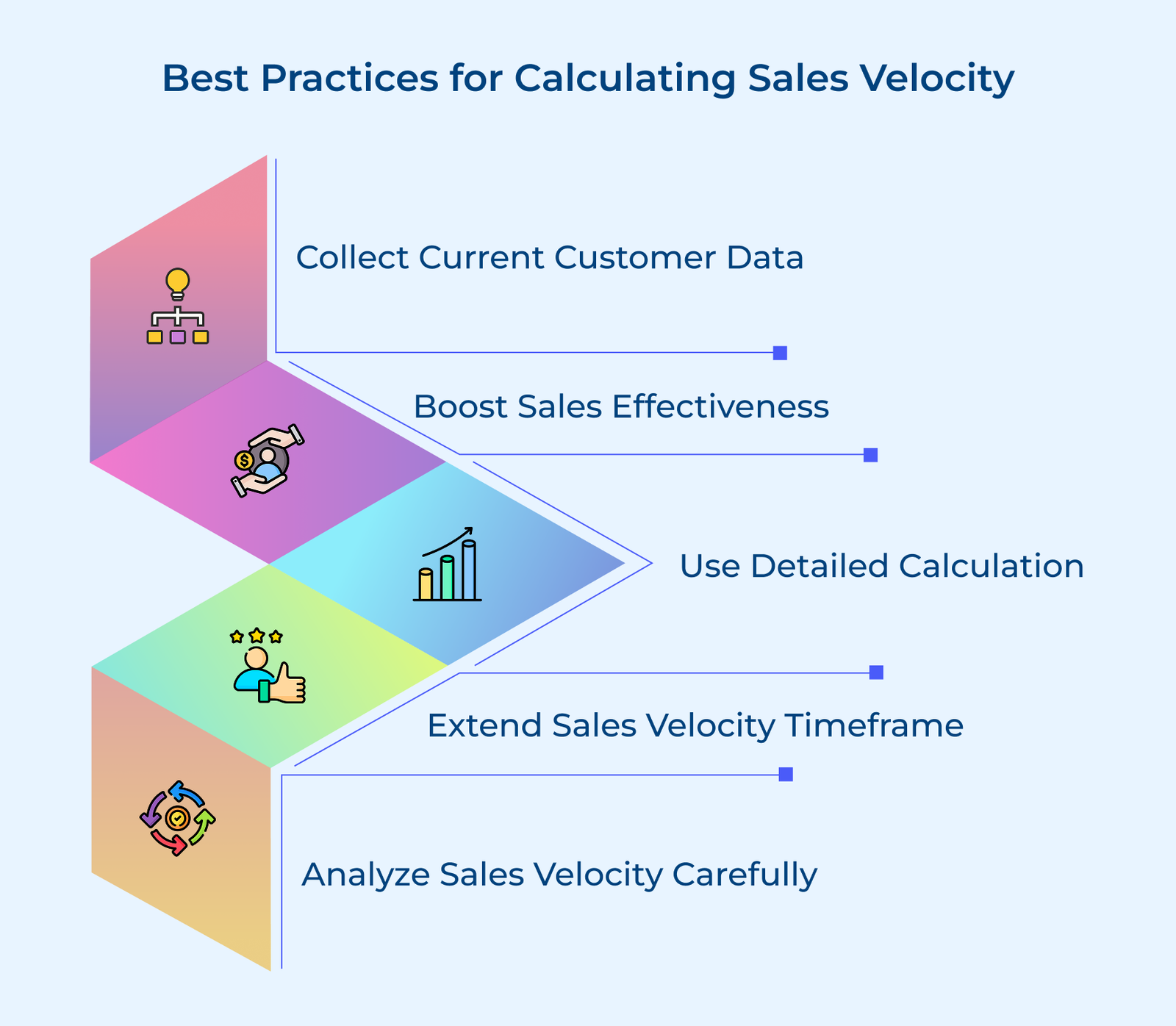
Accurate and up-to-date customer data is essential for reliable sales velocity calculations. Without precise details on opportunities, deal values, win rates and sales cycle lengths, your sales metrics may mislead you, resulting in poor decisions that could harm performance.
When you have trustworthy data, your sales velocity calculations reflect the true efficiency of your sales process. It empowers you to make informed decisions on resource allocation, pinpoint genuine areas for improvement and set achievable goals for your sales team.
Pro tips:
Sales effectiveness significantly influences key components of the sales velocity formula, especially win rate and average deal value. You can boost the factors by enhancing sales effectiveness, leading to a higher sales rate and ensuring you’re working smarter, not just faster.
Improving sales effectiveness can shorten sales cycles, elevate conversion rates and even increase deal sizes. You’ll drive improvements across the sales velocity spectrum by equipping your team with better skills, tools and strategies, paving the way for substantial, sustainable growth.
Actionable tips:
Analyzing sales velocity over longer periods offers a clearer picture of your performance, smoothing out short-term fluctuations that can mislead your strategy. The extended view reveals true trends, allowing you to identify seasonal variations and assess the impact of long-term strategies.
Businesses gain valuable insights that inform strategic decision-making by concentrating on sales rates over time. Tracking the rates allows companies to identify trends, seasonality and patterns in customer behavior, which can be crucial for forecasting future sales.
Actionable tips:
Breaking down sales velocity by segments such as product lines, customer types or sales territories offers deeper insights into your sales performance. The granular approach highlights specific strengths and weaknesses that might be hidden in overall metrics.
Segmented calculations enable you to tailor strategies to different areas of your business, allowing for more effective resource allocation, targeted improvement plans and customized goals. It leads to more efficient sales operations and optimized processes throughout your sales funnel.
Actionable tips:
Incorporating all relevant opportunities in your sales velocity calculations ensures a complete and accurate view of your pipeline. Excluding any can distort results and lead to misguided strategies. A holistic approach is vital for informed decision-making.
Businesses gain true insights into pipeline health and sales team performance by including every relevant opportunity. The thorough perspective enhances forecasting accuracy, optimizes resource allocation and clarifies where bottlenecks or inefficiencies may lie in your sales process.
Pro tips:
Sales velocity is a valuable metric, but it shouldn’t be viewed in isolation. External factors, market trends and internal shifts can impact sales rates, so it’s crucial to interpret the data carefully. The approach prevents hasty decisions based on potentially misleading information.
Interpreting sales velocity with caution allows you to incorporate it into a holistic sales analysis. Consider the metric alongside other KPIs, market trends and qualitative feedback from your team for a more comprehensive strategy. The balanced approach fosters stronger and more effective sales strategies.
Actionable tips:
We’ll explore real-world examples of sales velocity in action, showcasing how companies across industries use it to streamline processes, boost efficiency and accelerate revenue growth.

Software as a Service (SaaS) Company
A SaaS company offering project management tools may enjoy a high number of opportunities thanks to its broad market appeal. Their average deal size is moderate with tiered pricing plans.
Offering a user-friendly product or a free trial boosts their win rate, while a relatively short sales cycle allows businesses to quickly recognize value and implement the software. The winning combination drives high sales velocity, enabling the company to swiftly acquire customers and scale effectively.
Luxury Automotive Dealership
A high-end car dealership may have fewer opportunities due to its niche market, but the average deal size is significantly higher. While the win rate might be lower because of fierce competition, the sales cycle tends to be longer, involving multiple test drives, negotiations and financing discussions.
The sales cycle could be longer, involving multiple test drives, negotiations, and financing arrangements. Despite the lower volume, the substantial deal value can still yield impressive sales velocity.
Small Local Bakery
A neighborhood bakery enjoys a steady stream of daily opportunities from walk-in customers. While the average deal size is small, consisting of individual items or small orders, their win rate is high, boosted by loyal repeat customers and positive word-of-mouth.
The sales cycle is incredibly short, often just minutes from entry to purchase. The high volume and quick turnover can drive a strong sales velocity, even with lower individual transaction values.
Enterprise Software Solutions
A company providing custom enterprise software solutions targets a select number of large corporations, resulting in fewer opportunities. Each deal can be substantial, often reaching into the millions.
The win rate may be moderate due to fierce competition or lengthy evaluation processes, with sales cycles stretching over months. Involving multiple stakeholders, demonstrations and negotiations, the low volume can still yield impressive sales velocity when managed effectively.
Check out the effective techniques that can help you enhance your sales velocity and turn potential leads into loyal customers in record time.
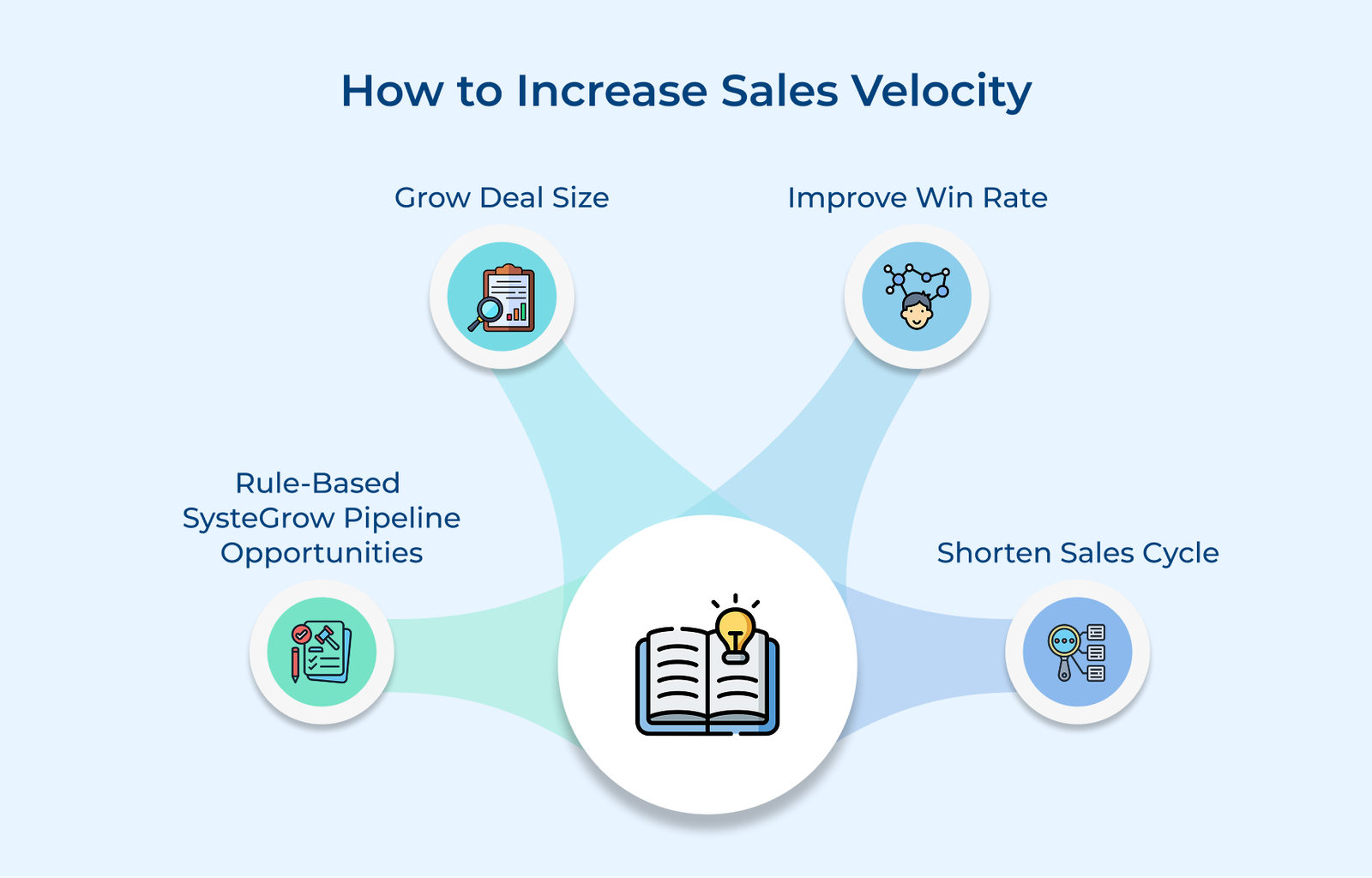
Examine your sales funnel to pinpoint and remove bottlenecks or unnecessary steps, creating a streamlined path from lead generation to closing. Utilize automation tools for repetitive tasks like follow-ups and data entry, enabling your sales team to concentrate on high-value activities that drive deals forward.
Create an effective lead scoring system to swiftly identify high-potential prospects. Train your team to ask targeted questions early to gauge buyer intent and fit. You’ll minimize time spent on unproductive opportunities and boost conversion rates by prioritizing qualified leads.
Build a centralized repository of current sales materials, product info and competitive insights. Conduct regular training sessions on new products, industry trends and winning sales techniques. It equips your salespeople to respond swiftly and confidently to buyer inquiries, speeding up the decision-making process.
Ensure marketing campaigns generate high-quality leads that align with your ideal customer profile. Establish a closed-loop feedback system where sales share insights on lead quality and customer pain points with marketing. The alignment creates more targeted campaigns, warming up leads before they reach sales and shortening the overall sales cycle.
Sales velocity is a vital metric for businesses looking to accelerate revenue growth. It reveals key insights into sales efficiency and effectiveness by tracking how quickly deals progress through the sales pipeline.
Enhancing sales velocity directly boosts revenue by increasing the conversion rate of opportunities into closed deals. The acceleration not only boosts immediate earnings but also strengthens long-term growth potential, enabling businesses to seize market opportunities swiftly and efficiently.
Key takeaways:
Sales velocity reveals how swiftly a company closes deals, offering crucial insights into customer behavior and preferences. Marketers can spot trends, understand buyer motivations and refine their messaging by analyzing the data. It enables them to craft compelling narratives that resonate with target audiences, boosting engagement and conversions.
The sales velocity formula measures how quickly a business generates revenue from sales within a specific timeframe. It’s calculated by multiplying the number of opportunities, win rate and average deal size, then dividing by the sales cycle length. The formula helps businesses assess their sales performance and pinpoint areas for enhancement.
Sales velocity is vital as it measures how quickly deals close within a specific timeframe. It reveals how effectively businesses convert leads into customers. A higher velocity signals a more efficient sales process, driving revenue and growth. Companies can optimize their strategies, forecast performance and make informed, data-driven decisions for success by tracking the metric.
Regularly measuring sales velocity is essential for staying updated on your sales performance. While many companies review it monthly or quarterly, analyzing it weekly may offer quicker insights for timely decision-making and adjustments, depending on your business’s nature.
Yes, sales velocity is a flexible metric applicable to various sales models, including B2B, B2C and e-commerce. It’s vital to tailor your calculations to fit the unique aspects of your sales process, such as the sales cycle length, product complexity and buyer decision-making.
Sales velocity is a key driver of business growth. Companies can accelerate revenue generation, reinvest in new opportunities and broaden their market reach by boosting velocity. Understanding and optimizing sales rates empowers businesses to make strategic decisions that align with their long-term goals, enhancing sustainable growth.
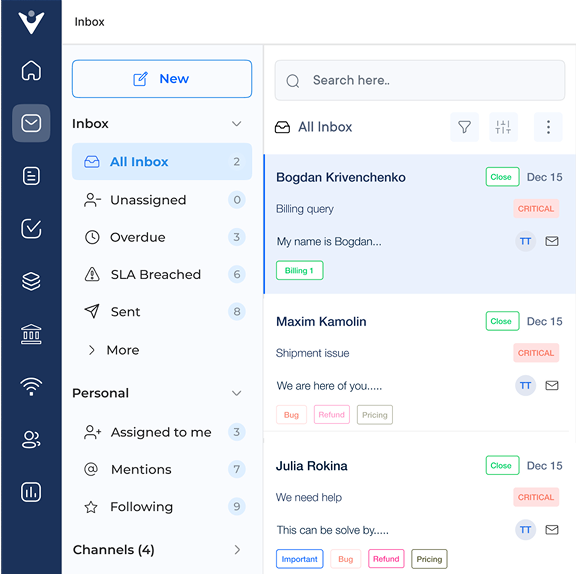
Market better, sell faster and support smarter with Veemo’s Conversation Customer Engagement suite of products.
Unify all your customer data in one platform to deliver contextual responses. Get a 360 degree view of the customer lifecycle without switching tools.
Connect with the tools you love to reduce manual activities and sync your business workflows for a seamless experience.
 https://veemo.io/wp-content/uploads/2024/12/customer-service-response-time.png
1256
2400
Webvision Solution
https://veemo.io/wp-content/uploads/2024/11/veemo.svg
Webvision Solution2025-10-17 10:51:142025-10-17 10:51:149 Effective Tips to Reduce Customer Service Response Time
https://veemo.io/wp-content/uploads/2024/12/customer-service-response-time.png
1256
2400
Webvision Solution
https://veemo.io/wp-content/uploads/2024/11/veemo.svg
Webvision Solution2025-10-17 10:51:142025-10-17 10:51:149 Effective Tips to Reduce Customer Service Response Time https://veemo.io/wp-content/uploads/2024/10/How-to-Create-Knowledge-Base.png
1257
2400
Vikas Sachan
https://veemo.io/wp-content/uploads/2024/11/veemo.svg
Vikas Sachan2024-10-21 12:24:342025-11-03 07:13:21How to Create a Knowledge Base in 9 Easy Steps: The Ultimate Guide
https://veemo.io/wp-content/uploads/2024/10/How-to-Create-Knowledge-Base.png
1257
2400
Vikas Sachan
https://veemo.io/wp-content/uploads/2024/11/veemo.svg
Vikas Sachan2024-10-21 12:24:342025-11-03 07:13:21How to Create a Knowledge Base in 9 Easy Steps: The Ultimate Guide https://veemo.io/wp-content/uploads/2024/02/Live-Chat-for-Sales.png
628
1200
teamwebvisionsolution@gmail.com
https://veemo.io/wp-content/uploads/2024/11/veemo.svg
teamwebvisionsolution@gmail.com2024-10-21 11:31:222025-08-06 10:22:06How to Use Live Chat for Sales? 7 Proven Ways to Grow Revenue
https://veemo.io/wp-content/uploads/2024/02/Live-Chat-for-Sales.png
628
1200
teamwebvisionsolution@gmail.com
https://veemo.io/wp-content/uploads/2024/11/veemo.svg
teamwebvisionsolution@gmail.com2024-10-21 11:31:222025-08-06 10:22:06How to Use Live Chat for Sales? 7 Proven Ways to Grow RevenueGrow Customer Relationships and stronger team collaboration with our range of products across the Conversational Engagement Suite.

 What is Team Management: A Comprehensive Guide with Tips
Scroll to top
What is Team Management: A Comprehensive Guide with Tips
Scroll to top